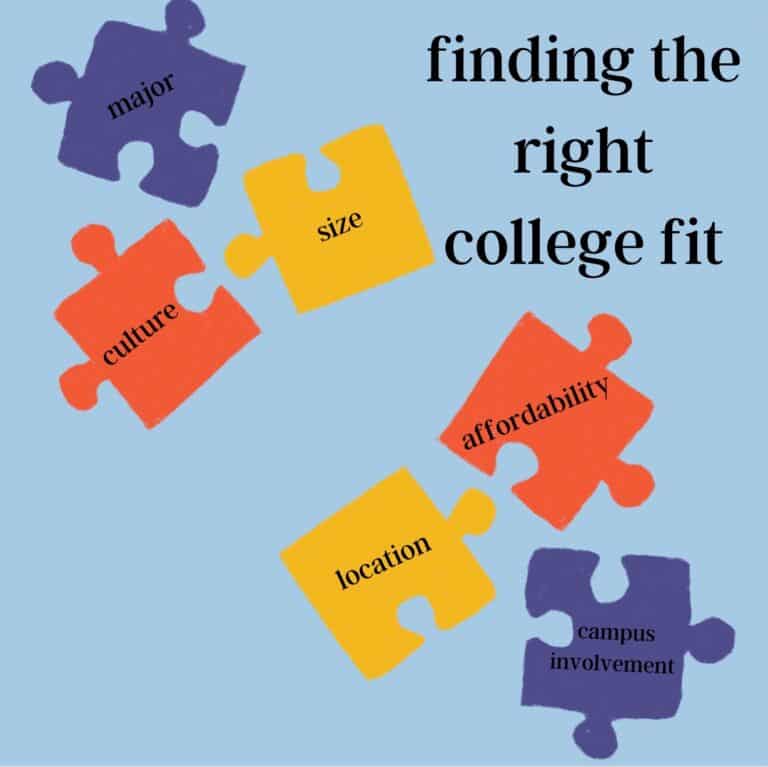
It’s easy to get caught up in the college admissions frenzy and subscribe to the idea that getting in to X or Y school is a coveted prize, one that validates a student’s effort, fuels a parent’s ego, and/or is the ticket to a successful future. But, college is neither a reward nor a final destination. Rather, it’s a once-in-a-lifetime experience designed to further students’ academic and personal growth and prepare them to confidently approach the next stage of their lives. The process of identifying colleges where students will feel comfortable and thrive academically, socially, and emotionally is often known as finding the right college fit.
Fit is as individualized as students themselves, and a school that is a great fit for one person may not be a match for another. There’s a reason, for example, why it’s inadvisable for someone to apply to all eight Ivy League schools or every university in the Big 10. Students should assess fit by reflecting on their personal and academic objectives to determine the attributes they are seeking in a college experience. If students already have some schools in mind, it’s helpful to drill down on why those institutions are attractive. By identifying the appealing characteristics of specific schools, students can begin searching for other schools with similar offerings. Here are some factors that students typically consider when evaluating colleges:
Academics. While it’s possible to get an excellent education at many universities, some colleges are a better academic fit for certain students than others. Students may be focused on pursuing a certain major or program or earning direct admission to a specific school (e.g., business or nursing). Some students may prioritize the ability to enter a university as an undecided student or they may be seeking particular research or study abroad opportunities. Other academic criteria that students evaluate include academic flexibility (the ability to easily change majors and/or double major and/or study in different departments), in-person (as opposed to online) instruction, and the existence or nonexistence of a core curriculum.
Location. Students may feel strongly about being close or far from home and/or in a city, college town, or rural environment. Many students view college as an opportunity to experience a new region for four years while others prefer to stay closer to home. Certain locations may be conducive to particular lifestyles and recreational opportunities—e.g., hiking, skiing, etc.—while urban locations may offer cultural and culinary outlets as well as internship opportunities. Many families value proximity to a major airport and/or ease of travel to/from home.
Weather. Some students prioritize certain types of weather for health reasons or personal preference.
Affordability. College is a significant investment, and the cost of tuition/living expenses as well as potential for need-based or merit aid can be important factors in choosing colleges.
Campus Culture/Community. Campuses are made up of many different types of students with varied interests, yet every college is characterized by an overarching culture. It’s important that applicants can see themselves fitting into the campus community. Some students thrive in a “work hard, play hard” environment while others are seeking an atmosphere that skews more in one direction or the other. Some students crave a campus culture that revolves around sports or a robust Greek system while other students are actively uninterested in this type of environment. The existence of subcommunities consisting of people with similar backgrounds or interests (e.g., Jewish community, First-Gen, Low-Income (FGLI), College Republicans, etc.) may also be important to students. Some students feel strongly about attending a school where they already know a few or many people while others are actively seeking a fresh start at a university where they know no one.
Size. Most students have a preference for either a small (<5,000 undergraduates), mid-size (5,000–15,000), or large (15,000+) institution. There are many ways to make a large school feel small (e.g., smaller majors, honors programs, student organizations, etc,), and some ways to make a small school feel larger (e.g., urban location, consortium with other colleges). Faculty-student ratio and average class sizes are other metrics that some students value. High school students are often shocked to learn that college classes at some large universities contain 1000+ students (and are often offered online).
It can be challenging to identify colleges that check every single box on a student’s wish list, which is why it’s critical that students reflect on their priorities and decide which factors are nonnegotiable and which are potentially expendable. Certain criteria, such as weather and distance from home, are unchangeable while others are potentially more malleable (e.g., there are ways to find community within a large school). While evaluating fit can be time-consuming, taking the time to do so as a prospective applicant greatly lessens the likelihood that a student will end up unhappy, seek to transfer, or drop out altogether. After all, college is a significant investment of time and money, and getting in is just the beginning of a journey that continues well after the excitement of the sweatshirt or bumper sticker wears off.
